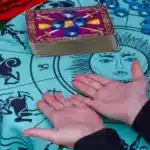Are you curious about what your palms say about your future? Chinese palmistry might have the answers you’re looking for. Unlike Western palmistry, which often focuses on symbolic interpretations of the lines and mounts on your hand, Chinese palmistry blends ancient wisdom with a holistic view of your life. From understanding your personality traits to predicting your life’s journey, Chinese palmistry offers a fascinating glimpse into your future.
In this article, we’ll explore the intricate world of Chinese palmistry. We’ll explain how it differs from Western methods, its origins, and the main principles guiding this practice. You’ll also discover the key lines and their meanings, how to ask the right questions during a reading, and whether Western palm readers can apply Chinese techniques. By the end, you’ll have a clear understanding of how Chinese palmistry works and how it can provide insights into your life.
Table of Contents
- How does Chinese Palmistry Differ from Western?
- Is Chinese Palmistry Accurate?
- Origins of Chinese Palm Readings
- Main Principles in Chinese Palmistry
- Key Lines and Meanings in Chinese Palmistry
- Can Western Palm Readers Apply Techniques from Chinese Palmistry?
- What to Ask During a Chinese Palm Reading
- Conclusion
How does Chinese Palmistry Differ from Western?
Chinese and Western palmistry share some common ground but differ in techniques and philosophies. Western palmistry focuses on the symbolism of hand features, interpreting them to reveal personality traits and life events. It’s an art steeped in mystery and individual interpretation.
Chinese palmistry takes a more structured and holistic approach. It integrates traditional Chinese medicine, philosophy, and cosmology. This practice examines not just the lines and mounts on the hand but also the shape, fingers, and even the color and texture of the skin. This comprehensive analysis aims to provide a detailed picture of your overall well-being and destiny.
While Western palmistry often centers on an individual’s psychological aspects, Chinese palmistry links hand features to different elements and energies that influence various life areas. This means a Chinese palmistry reading can offer more specific predictions and advice on health, career, and relationships based on ancient Chinese wisdom.
Is Chinese Palmistry Accurate?
The accuracy of Chinese palmistry is a common topic of discussion. With deep historical roots and a comprehensive approach, many practitioners and enthusiasts consider it highly accurate. The practice has evolved over thousands of years, combining observation with principles from traditional Chinese medicine and cosmology.
Chinese palmistry’s detailed approach, examining the lines, shape, texture, and color of the hand, allows palmists to gather a wealth of information. This holistic analysis can provide specific insights and predictions that often resonate deeply with individuals. Many find their readings accurately reflect their personalities, past experiences, and potential future events.
However, remember that no divination method can guarantee 100% accuracy. Palmistry is best viewed as a tool for guidance and self-reflection rather than a definitive prediction of the future. The skill and experience of the palmist also play a significant role in the accuracy of a reading.
Origins of Chinese Palm Readings
Chinese palmistry dates back over 3,000 years to the Zhou Dynasty, deeply rooted in traditional Chinese medicine and philosophy. It was developed to diagnose health conditions and provide insights into a person’s character and destiny.
Chinese palmistry evolved alongside face reading (physiognomy) and astrology, often used together for a comprehensive analysis of an individual’s life and future. Ancient Chinese scholars and physicians believed that the body, including the hands, reflected a person’s internal energy and health.
Taoist and Confucian philosophies also influenced palmistry. Taoism’s focus on harmony and balance and Confucianism’s emphasis on ethics and morality play roles in how palmists interpret hand features. Passed down through generations, Chinese palmistry remains widespread in China and other parts of Asia and is studied by palmists worldwide.
Main Principles in Chinese Palmistry
Chinese palmistry is built on several fundamental principles that guide hand analysis. Understanding these principles can help you appreciate the depth and complexity of this ancient practice.
Balance and Harmony
Balance and harmony are core principles in Chinese palmistry, rooted in Taoist philosophy. Palmists look for signs of imbalance or disharmony in the hand, which can indicate potential challenges or areas for improvement in your life.
Elements and Energies
Chinese palmistry incorporates the Five Elements theory, a cornerstone of traditional Chinese medicine. The five elements – wood, fire, earth, metal, and water – represent different energies and qualities. Each element is associated with specific traits, and palmists use this theory to interpret hand features.
Holistic Analysis
A key difference between Chinese and Western palmistry is the holistic nature of the analysis. Chinese palmists examine not just the lines but also the shape, size, and color of the hand, fingers, and nails. This comprehensive approach provides a detailed picture of an individual’s health, personality, and destiny.
Key Lines and Meanings in Chinese Palmistry
In Chinese palmistry, the lines on the hand are seen as maps of a person’s life journey. Each line has its significance and can provide insights into different aspects of your life. Here are the key lines and their meanings:
Life Line
The Life Line begins between the thumb and index finger and curves down towards the base of the palm. Contrary to popular belief, it doesn’t indicate how long you will live but rather the quality and vitality of your life. A long, deep Life Line suggests robust health and a vibrant life, while a short or faint one may indicate potential health challenges or a more cautious approach to life.
Wisdom Line
The Wisdom Line, or Head Line, runs horizontally across the middle of the palm. This line represents your intellect, thought processes, and problem-solving approach. A long, clear Wisdom Line suggests strong analytical and logical abilities, while a shorter one may indicate a more intuitive and spontaneous thinking style.
Love Line
The Love Line, or Heart Line, runs horizontally across the top of the palm, just below the fingers. This line is associated with your emotional life, relationships, and capacity for love and compassion. A deep, unbroken Love Line suggests a stable and fulfilling emotional life, while breaks or forks can indicate challenges or changes in relationships.
Fate Line
The Fate Line, also known as the Destiny Line, runs vertically from the base of the palm toward the fingers. This line represents your career, achievements, and life path. A strong, straight Fate Line suggests a clear sense of purpose and direction in life. A broken or irregular Fate Line can indicate changes or obstacles in your career or life path. The presence or absence of this line can also provide insights into the role of fate and free will in your life.
Can Western Palm Readers Apply Techniques from Chinese Palmistry?
Western palm readers can definitely benefit from incorporating Chinese palmistry techniques into their practice. The holistic approach and emphasis on balance and harmony can add depth and nuance to their readings. By integrating the Five Elements theory and the Yin and Yang concept, Western palmists can offer more comprehensive and insightful readings.
Western palmists can also learn to examine the hand’s shape, size, color, and lines to understand their clients fully. However, it’s important for Western palmists to approach Chinese palmistry respectfully and with an open mind. Understanding the cultural and philosophical context of the practice is crucial for providing accurate and meaningful readings. With careful study and practice, Western palm readers can enrich their skills and offer their clients more detailed and nuanced insights.
What to Ask During a Chinese Palm Reading
If you’re considering a Chinese palm reading, knowing what questions to ask is helpful to get the most out of your session. Here are some suggestions:
- Relationships: What does my hand reveal about my emotional life and relationships? Are there any patterns or issues I should address?
- Life Path: What can you tell me about my life’s journey and purpose? Are there any significant events or changes I should prepare for?
- Personal Growth: How can I achieve balance and harmony in my life? What areas should I focus on for personal development and growth?
- Family: What insights can you provide about my family dynamics and relationships? Are there any potential challenges or strengths I should be aware of?
- Inner Strength: How can I tap into my inner strength and resilience? What does my hand say about my ability to handle challenges and adversity?
By asking these questions, you can gain valuable insights into various aspects of your life and make the most of your Chinese palm reading.
Conclusion
Chinese palmistry offers a fascinating and insightful way to explore your life’s journey. With its deep roots in traditional Chinese medicine, philosophy, and cosmology, this ancient practice provides a comprehensive and holistic analysis of your hand’s features. By understanding the key lines and their meanings, the principles that guide the practice, and how to ask the right questions during a reading, you can gain valuable insights into your health, career, relationships, and overall well-being.
Whether you’re a curious newcomer or a seasoned palmistry enthusiast, exploring Chinese palmistry can enrich your understanding of yourself and your life’s path. So why not look closer at your hands and see what secrets they hold?











